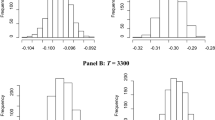Abstract
The paper deals with the analysis of the empirical distribution of returns of selected market indices of developed and developing markets in relation to applications in the field of financial risks. The probability distribution of returns plays a key role for both the theoretical and practical part of financial theory. The assumption of a normal distribution of returns, which is crucial for several financial theories, is rejected in line with our analysis of the daily returns of 30 markets. From the perspective of financial risk assessment, the choice of an appropriate distribution is key to the accuracy of the achieved results. In this paper, we examine the possibility of applying alternative distributions, in order to better capture the observed leptokurtic behavior of the empirical distribution of daily returns as compared to the assumption of normality. We perform the analysis on the daily returns of stock market indices in order to examine the possible differences between the empirical distribution of developed and emerging markets. We investigate the suitability and relative performance of these alternative distributions: the generalized skewed t distribution (sgt), the generalized lambda distribution (gld), the exponential power distribution (GED), the Hansen's skewed t distribution and the Laplace distribution. The best relative performance of fit for market index returns providing the sgt_2 and gld distributions, with gld appearing to be a more prominent adept than with the perspective of relative stability of quality of fit and also quality of risk estimation.





Similar content being viewed by others
References
Ágoston K (2012) CVaR minimization by the SRA algorithm. CEJOR 20:623–632
Amaya D, Christoffersen P, Jacobs K, Vasquez A (2015) Does realized skewness predict the cross-section of equity returns? J Financ Econ 118:135–167
Artzner P, Delbaen F, Jean-Marc E, Heath DD (1999) Coherent measures of risk. Math Financ 9(3):203–228
Basak S, Shapiro A (2001) Value-at-risk based risk management: optimal policies and asset prices. Rev Financial Studies 14(2):371–405
Behr A, Pötter U (2009) Alternatives to the normal model of stock returns: Gaussian mixture, generalized logF and generalised hyperbolic models. Ann Finance 5(1):49–68
Bollerslev T (1986) Generalized autoregressive conditional heteroscedasticity. J Econom 31(3):307–327
Burnham PK, Anderson RD (2004) Multimodel inference: understanding AIC and BIC in model selection. Sociol Methods Res 33:261–304
Corlu GC, Meterelliyoz M, Tiniç M (2016) Empirical distributions of daily equity index returns: a comparison. Expert Syst Appl 54:170–192
Dean B (2013) Improved estimation and regression techniques with the generalized lambda distribution. PhD. The University of Newcastle, Australia, Faculty of Science and Information Technology
Engle R (1982) autoregressive conditional heteroscedasticity with estimates of the variance of United Kingdom inflation. Econometrica 50(4):987–1007
Fama E (1965) The behavior of stock market price. J Bus 38(1):34–105
Freimer M, Kollia G, Mudholkar GS, Lin CT (1988) A study of the generalized Tukey lambda family. Commun Stat-Theory Methods 17(10):3547–3567
Glawischnig M, Seidl I (2013) Portfolio optimization with serially correlated, skewed and fat tailed index returns. CEJOR 21(1):153–176
Gray JB, French DW (1990) Empirical comparisons of distributional models for stock index returns. J Bus Financ Acc 17(3):451–459
Hansen BC, Mcdonald BJ, Newey KW (2010) Instrumental variables estimation with flexible distributions. J Bus Econ Stat 28(1):13–25
Harris RD, Küçüközmen CC (2001) The empirical distribution of UK and US stock returns. J Bus Financ Acc 28(5):715–740
Hull J, White A (1987) The pricing of options on assets with stochastic volatilities. J Financ 42(2):281–300
Kara G, Özmen A, Weber GW (2019) Stability advances in robust portfolio optimization under parallelepiped uncertainty. Cent Eur J Oper Res 27:241–261
Krämer W (2021) Asymmetry in the distribution of daily stock returns. Empir Econ 60(1):1115–1125
Lemperiere Y, Deremble C, Nguyen TT, Seager P, Potters M, Bouchaud JP (2017) Risk premia: asymmetric tail risks and excess returns. Quant Finance 17(1):1–14
Mandelbrot B (1963) The variation of certain speculative prices. J Bus 36(4):394–419
Massing T (2019) What is the best Lévy model for stock indices? A comparative study with a view to time consistency. Financ Mark Portf Manag 33:277–344
Peters E (1991) Chaos and order in the capital markets. A new view of cycles, prices, and market volatility. Wiley, New York
Praetz P (1972) The distribution of share price changes. J Bus 45(1):49–55
Rootzén H, Klüppelberg C (1999) A single number can’t hedge against economic catastrophes. Ambio 28(6):550–555
Theodossiou P (1998) financial data and the skewed generalized T distribution. Manage Sci 44(12):1650–1661
Tukey JW (1960) The practical relationship between the common transformations of percentages or fractions and of amounts. Technical Report 36, Statistical Research Group, Princeton
Yamai Y, Yoshiba T (2002) On the validity of value-at-risk: comparative analyses with expected shortfall. Monet Econ Stud 20(1):57-85
Acknowledgements
This work was supported by the Grant Agency of Slovak Republic – VEGA grant no. 1/0339/20 “ Hidden Markov Model Utilization in Financial Modeling ”.
Author information
Authors and Affiliations
Corresponding author
Additional information
Publisher's Note
Springer Nature remains neutral with regard to jurisdictional claims in published maps and institutional affiliations.
Appendix
Appendix
See Figs. 6, 7, 8, 9, 10, 11, 12, and 13.
Comparison of differences between AIC values of selected model and AIC of best model for individual two-year subperiods and developed markets. The interpretation of the graphs is as follows. For TA125.TA and subperiod 90_91 the model with the lowest AIC value is gld, for Laplace, sgt_1, sgt_2 and GED it is true that ∆AIC is less than 10, (on the graph highlighted by a black dotted line) which means we cannot unambiguously exclude the given models as unsuitable alternatives. The normal distribution provides a comparatively poorer quality of adaptation than other alternatives
Rights and permissions
About this article
Cite this article
Pekár, J., Pčolár, M. Empirical distribution of daily stock returns of selected developing and emerging markets with application to financial risk management. Cent Eur J Oper Res 30, 699–731 (2022). https://doi.org/10.1007/s10100-021-00771-4
Accepted:
Published:
Issue Date:
DOI: https://doi.org/10.1007/s10100-021-00771-4












